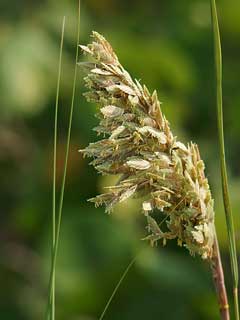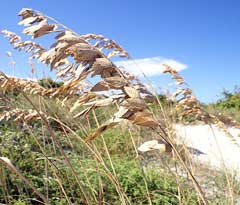 |
|
commons.wikimedia.org/wiki/User:Biopics |
 |
| commons.wikimedia.org/wiki/User:Dpalma01 |
Translate this page:
Summary
Bloom Color: Brown. Main Bloom Time: Late summer, Mid summer. Form: Upright or erect.
Physical Characteristics

 Uniola paniculata is a PERENNIAL growing to 2.5 m (8ft 2in) at a medium rate.
Uniola paniculata is a PERENNIAL growing to 2.5 m (8ft 2in) at a medium rate.
See above for USDA hardiness. It is hardy to UK zone 7. It is in flower from July to August. The species is hermaphrodite (has both male and female organs) and is pollinated by Wind.
Suitable for: light (sandy) and medium (loamy) soils. Suitable pH: mildly acid, neutral and basic (mildly alkaline) soils and can grow in saline soils.
It can grow in semi-shade (light woodland) or no shade. It prefers moist soil. The plant can tolerate maritime exposure.
UK Hardiness Map
US Hardiness Map
Synonyms
Plant Habitats
Cultivated Beds;
Edible Uses
Edible Parts: Seed
Edible Uses:
Seed - cooked and eaten as a cereal[177, 183]. Said to have a very good flavour[183]. Seed production in the wild is generally poor[270].
References More on Edible Uses
Medicinal Uses
Plants For A Future can not take any responsibility for any adverse effects from the use of plants. Always seek advice from a professional before using a plant medicinally.
None known
References More on Medicinal Uses
The Bookshop: Edible Plant Books
Our Latest books on Perennial Plants For Food Forests and Permaculture Gardens in paperback or digital formats.

Edible Tropical Plants
Food Forest Plants for Hotter Conditions: 250+ Plants For Tropical Food Forests & Permaculture Gardens.
More

Edible Temperate Plants
Plants for Your Food Forest: 500 Plants for Temperate Food Forests & Permaculture Gardens.
More

More Books
PFAF have eight books available in paperback and digital formats. Browse the shop for more information.
Shop Now
Other Uses
Soil stabilization
The spreading root system of this plant make it useful for stabilizing drifting coastal sand dunes[1, 200, 236].
Special Uses
References More on Other Uses
Cultivation details
Landscape Uses:Erosion control, Ground cover, Seashore. Prefers a moist sandy soil, tolerating some shade[200]. Tolerates maritime exposure and saline soils[200]. An invasive plant, spreading freely by means of its rhizomes[236], but it is very ornamental[200]. and is well worth a place in the garden. Special Features:North American native, Naturalizing, Attractive flowers or blooms.
References Carbon Farming Information and Carbon Sequestration Information
Temperature Converter
Type a value in the Celsius field to convert the value to Fahrenheit:
Fahrenheit:
The PFAF Bookshop
Plants For A Future have a number of books available in paperback and digital form. Book titles include Edible Plants, Edible Perennials, Edible Trees,Edible Shrubs, Woodland Gardening, and Temperate Food Forest Plants. Our new book is Food Forest Plants For Hotter Conditions (Tropical and Sub-Tropical).
Shop Now
Plant Propagation
Seed - sow early spring in situ and only just cover the seed[1]. Division in spring[200].
Other Names
If available other names are mentioned here
Native Range
NORTHERN AMERICA: United States (Alabama (south), Florida (coasts), Georgia (southeast), Louisiana (south), Maryland (east), North Carolina (east), South Carolina, Virginia (southeast), Mississippi (south), Texas), Mexico (Tamaulipas (coastal dunes), Chiapas (coastal dunes), Tabasco (coastal dunes), Veracruz de Ignacio de la Llave (coastal dunes), Yucatán (coastal dunes)) SOUTHERN AMERICA: Bahamas, Cuba
Weed Potential
Right plant wrong place. We are currently updating this section.
Please note that a plant may be invasive in one area but may not in your area so it's worth checking.
Conservation Status
IUCN Red List of Threatened Plants Status :

Growth: S = slow M = medium F = fast. Soil: L = light (sandy) M = medium H = heavy (clay). pH: A = acid N = neutral B = basic (alkaline). Shade: F = full shade S = semi-shade N = no shade. Moisture: D = dry M = Moist We = wet Wa = water.
Now available:
Food Forest Plants for Mediterranean Conditions
350+ Perennial Plants For Mediterranean and Drier Food Forests and Permaculture Gardens.
[Paperback and eBook]
This is the third in Plants For A Future's series of plant guides for food forests tailored to
specific climate zones. Following volumes on temperate and tropical ecosystems, this book focuses
on species suited to Mediterranean conditions—regions with hot, dry summers and cool, wet winters,
often facing the added challenge of climate change.
Read More
Expert comment
Author
L.
Botanical References
43200
Links / References
For a list of references used on this page please go here
Readers comment